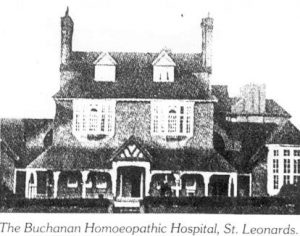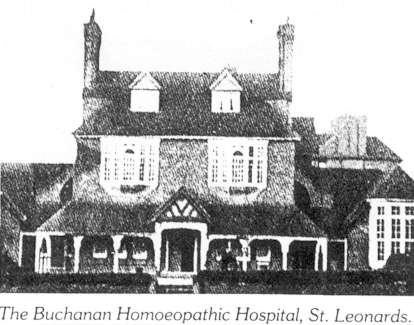
Elizabeth Mirrlees (3 November 1829 – 17 June 1902) was a Scottish-born philanthropist and staunch supporter of homeopathy. In 1881, she founded the Buchanan Homeopathic Hospital at St. Leonards-on-Sea, Sussex, in memory of her aunt, Joanna Buchanan (1797 – 1881).
Elizabeth Mirrlees remained as benefactor and driving force of the hospital, serving as its “Lady Manager” and Honorary Treasurer.
Elizabeth Mirrlees was born in Lanarkshire, Scotland, on 3 November 1829, to Glasgow saddle manufacturer William Mirrlees (1786 – 1853) and Elisabeth Buchanan (1791 – 1874).
It is not known when, or why, Elizabeth Mirrlees moved from Glasgow to the south coast of England, but her eldest brother, William Mirrlees (1815 – 1868) had settled in the Hastings area as a merchant saddler, presumably on behalf of their father’s business.
By the end of 1880, Elizabeth and her aunt Joanna were evidently familiar with the homeopathic treatment available at the Hastings and St. Leonards Homoeopathic Dispensary. According to a brief history of the Buchanan Hospital, found in the 1909 Buchanan Hospital Annual Report, they were also aware of the Dispensary’s limitations and decided on a solution:
The want of a Hospital for the further treatment of severe cases from the Eye Department of the Hastings and St. Leonards Homoeopathic Dispensary prompted Miss Buchanan to suggest the provision of a Cottage Hospital for that purpose. She did not live to see her wish fulfilled, but her niece, Miss Elizabeth Mirrlees, generously determined to carry it out.
With the co-operation of Mrs. Shaw, Miss Goldson, Miss Kingsbury, Mrs. Vores, Mrs. Mason, and others, a Hospital with six beds was opened at 24, Southwater Road, Miss Mirrlees providing the building, free of rent, with a considerable sum of money, as a temporary arrangement, giving it the name of “‘Buchanan Cottage Hospital” in memory of her aunt, Miss Buchanan, Mr. Knox Shaw being the Medical Officer in charge.
In the Homoeopathic World of May 1882, a first year report for the new Buchanan Ophthalmic and Cottage Hospital at 24 Southwater Road, St Leonards-on-sea, was published:
At a meeting held in February, 1881, a resolution was framed based upon the liberal offer of Miss Mirrlees, to start a cottage hospital, for the reception of ophthalmic and acute medical and surgical cases. Subsequent meetings were held, and it was finally decided to open the Hospital, in temporary premises, at 24, Southwater Road, kindly offered by Miss Mirrlees, rent free.
The opening ceremony took place on Monday, April 11th, the Venerable Archdeacon Huxtable conducting a short and impressive dedication service.
The sincere thanks of the managers are due to the numerous kind friends who have given their generous support to the Institution, both in money and in gifts. Their ready help and encouraging sympathy have materially assisted them in their undertaking. The Hospital contains six beds, and during the nine months that it has been opened, 49 cases have received the benefits of the Institution:
- 40 Cases admitted into the Hospital.
- 5 Cases admitted for operation, and discharged the same day.
- 4 Casualty cases, treated as out-patients
- TOTAL 49
Of the 40 in-patients, 11 were males, 29 females; 15 being ophthalmic cases:
- 29 were discharged cured.
- 12 were materially benefited.
- 2 incurable.
- 1 died
- 5 remained in the Hospital at the close of the year.
- TOTAL 49
The average length of stay in the Hospital was 22.67 days, and the cost per patient was £3 13s. The average weekly cost per patient was £1 2s. 9d.
The expenses of the year have been £317 9s 9¾d., the receipts £372 12s 4d., thus leaving a balance in hand of £55 2s 6¼d. About £130 has been spent in furnishing and fitting up the Hospital.
A plot of land at the junction of the Springfield and London Roads has been generously given by Charles Eversfield, Esq., and it is proposed shortly to erect thereon a suitable building for a cottage hospital. An account has been opened at the London and County Bank, Hastings, for the Building Fund, towards which £1,210 has been already promised. Contributions to this fund may be paid direct to the bank or to the treasurer.
Subscriptions for the year 1882 are now due, and will be gladly received by the treasurer, Miss Mirrlees, 68, Warrior Square, St. Leonards.
We congratulate Mr. Knox Shaw, the honorary medical officer, on this brilliant beginning.
Elizabeth Mirrlees was imbued with a Victorian philanthropic consciousness. She disbursed large sums of her personal fortune to good causes, including supporting local charities and clergy. The Buchanan Hospital, however, was her primary concern and she remained directly involved with the hospital until the end of her life.
Elizabeth Mirrlees died at her home, 66 Warrior Square, St Leonards-on-Sea, on Tuesday 17 June, 1902. She was buried at St Andrews Fairlight Parish Church, alongside her mother, brother William, and aunt Joanna Buchanan.
Of Interest:
Elizabeth Mirrlees‘ third eldest brother, James Buchanan Mirrlees (1822 – 1903), was a mechanical engineer. He became a founder partner in Mirrlees-Watson (after, Mirrlees-Blackstone), a Glasgow engineering firm that became one of the world’s leading manufacturers of sugar mill machinery and, later, the first exclusive British licence holder and builder of Diesel engines. J. B. Mirrlees made a fortune from this business and in 1870 built an Italianette villa, Redlands House, on Great Western Road, Glasgow. In the early 20th century the house was converted into Redlands Hospital for Women.



i’m always curious why individual homeopathic hospitals closed. Do you have any insight about this important question?
Dana, it is a very important question, but with no single answer. The quick response would be to say “World War 2,” but that doesn’t really tell the entire story. Long term, the system of voluntary and charitable hospitals in Britain, homeopathic and orthodox, became too costly in the early 20th century. Counterintuitively, hospitals expanded and built new wings and modern facilities to meet the needs of local populations, all the while hemorrhaging money. WW2 finally ended this protracted over-extension and unraveling of the 19th century hospital system. The rationalizing and coordination of the hospital network under the NHS in 1948 resulted in the closure of some of these hospitals, and the appropriation of others as orthodox hospitals. The Buchanan was an example of the latter. It lasted just over a century, finally closed in 1983. However, it had long ceased offering homeopathic treatment. There were of course the five homeopathic hospitals that did survive, and remained part of the NHS for decades: Royal London, Glasgow, Bristol, Liverpool and Tunbridge Wells. Their recent fates are another story. ~MD
Redlands House is still standing and handsome too, – https://www.flickr.com/photos/seapigeon/708222903
What a splendid-looking building it is! Thanks for sharing Allan.